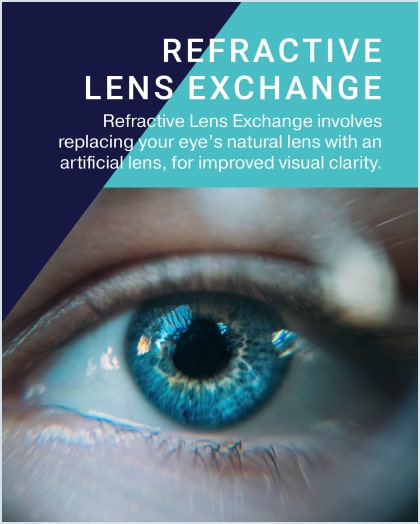Understanding refractive lens exchange
Refractive lens exchange is designed to reduce dependence on glasses or contacts. Increasingly popular for people in their 40s and 50s, the surgical procedure replaces the eye’s natural lens with an artificial one – an intraocular lens (IOL) – to correct focusing errors and sharpen vision.
In normal vision, light passes through the cornea, pupil and lens to reach the light-sensitive retina at the back of the eye. The cornea and the lens work together to focus images onto the retina. In people with myopia (near sightedness), astigmatism or hyperopia (farsightedness), this focus is compromised, causing objects to look blurry or unfocused at different distances, depending on the issue.
Even without a specific vision problem, ageing can affect vision. Your lenses stiffen after 40, reducing your ability to switch focus between near and distant objects. By the age of 50, most people have lost this ability.
Reasons for surgery
Refractive lens exchange can be helpful if you have myopia, astigmatism or hyperopia or are struggling to focus as you age. Sometimes called ‘lifestyle lenses’, artificial lenses may not restore perfect vision, but they can make it easier for you to manage daily life – for example, reading menus, road signs or supermarket prices without glasses.
Refractive lens replacement in your 40s or 50s can also eliminate the need for cataract surgery. This surgery, usually required later in life, is essentially the same procedure. The only difference is that the lens is replaced because it is clouded with cataracts that damage vision. If you have refractive lens replacement earlier, the new lenses won’t become clouded so there’s no need for further surgery.
Anatomy of the human eye

Types of lens
Different types of IOL are used, depending on your specific vision issues and your eye health.
Monofocal/fixed-focus lens
Often used to correct or improve astigmatism, this lens helps sharpen distant, intermediate and close vision – but cannot improve all three at once.
Multi-focal lens
This lens gives clarity at multiple distances, improving general vision in most people. However, it can cause ‘haloes’ around lights and ‘starburst’ effects, particularly at night.
Extended depth of focus (EDOF) lens
An EDOF lens works by spreading light over a greater distance, giving you a wider range of vision without ‘gaps’ or problems switching focus. Unlike a multi-focal IOL, it’s unlikely to cause halo effects or other night vision issues.

The procedure
Refractive lens exchange is a fairly straightforward procedure, usually performed on outpatients. In most cases, you will have a separate surgery scheduled for each eye. The procedure takes about 20 minutes, with local anaesthetic or numbing eye drops used to minimise discomfort.
During the procedure, your surgeon uses a scalpel or laser to make one or two small incisions in the side of the eye. A small probe breaks up the natural lens, and gentle suction removes it from the eye. Finally, the IOL, or artificial lens, is inserted. It’s usually folded for easier insertion, and unfolds once inside the eye. Because the incisions are so small, there is no need for stitches, and the eye should heal rapidly.
Recovery
After surgery, recovery can take several weeks – although most people can return to work and normal activities after a week. Your vision may be blurred, bright lights may seem particularly ‘glary’ and you may notice disturbances like haloes around lights. Your eyes may feel slightly scratchy as they heal, and your ophthalmologist will prescribe lubricating drops to help.
IOLs are designed to last for the rest of your life and are not affected by age-related vision changes. Most patients are very happy with the outcome, reporting clearer vision and reduced need for glasses or contact lenses. However, around 10% of patients may experience gradual blurring of vision due to the thickening of the capsule around the artificial lens. If this happens, talk to your ophthalmologist who can usually restore your vision with a simple laser procedure to loosen the lens capsule.










